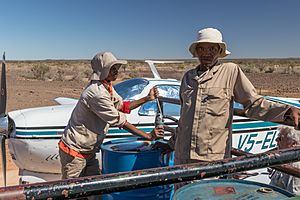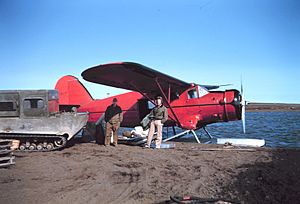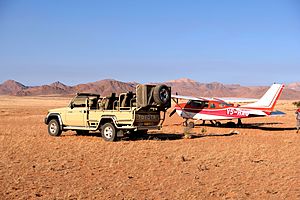Bush flying facts for kids
Bush flying is when airplanes fly to wild, remote places. These areas, often called "the bush," usually don't have proper runways. Because of this, bush planes need special gear. They might have extra-large tires, floats for water, or skis for snow. This type of flying is often the only way to get people and supplies to faraway, hard-to-reach spots.
Contents
What is Bush Flying?
The word bush has been used since the 1800s. It describes wild, remote areas far from towns. So, bush flying means flying planes in these distant, wild regions. In places like Australia, "the bush" refers to areas others might call forests or wilderness.
Why is Bush Flying Important?

Bush flying is often the main way to travel in many remote parts of the world. This includes places like Northern Canada, Alaska, and the Australian Outback. Sometimes, it's the only way to reach these areas. It helps deliver mail, food, medicine, and people to isolated communities.
The History of Bush Flying
Bush flying first became important for exploring new lands and helping them grow. In Alaska, it was mostly used for transportation. Later, bush planes and pilots became vital for rescue missions. Bush pilots are very important for many different reasons.
Bush Flying in Canada
After World War I ended in 1918, a Canadian forester named Ellwood Wilson had an idea. He worked for the Laurentide Company in Quebec. Wilson realized that planes could help spot forest fires and create maps of wooded areas.
In early 1919, Wilson learned the U.S. Navy was giving Canada some extra planes from the war. These were Curtiss HS-2L flying boats. He asked to borrow two of them. Then, he hired Captain Stuart Graham to fly the planes.
Graham and his engineer, Walter Kahre, flew the first HS-2L to Lac-à-la-Tortue, Quebec. They arrived on June 8, 1919. This flight covered 645 miles. It was the longest cross-country flight ever done in Canada at that time.
With these planes, the first bush flights began in the summer of 1919. They started fire patrols and took aerial photos in the Saint-Maurice River valley. Graham and Kahre continued this work for two more years. But it became very expensive. So, the Laurentide Company created a new business. It was called Laurentide Air Services Ltd. Wilson became its president. This was the start of bush flying in Eastern Canada.
In Western Canada, a pilot named Wilfrid May moved to Edmonton. A businessman offered the city a Curtiss JN-4 plane. Mayor Joe Clarke and the city council accepted the gift. May then asked to rent the plane. They agreed on a price of CA$25. May and his brother formed May Airplanes Ltd. George Gorman, a pilot, and Peter Derbyshire, a mechanic, joined them. This was the start of commercial bush flying in Western Canada.
May then asked the Edmonton Journal newspaper to fly copies to Wetaskiwin. This town was about 70 km (43 mi) south of Edmonton. The newspaper agreed. The next day, Gorman and Derbyshire flew the newspapers. They also carried two bags of advertisements. They followed the train tracks, telling communities along the way about the new service.
Today, bush flying in Canada is celebrated at the Canadian Bushplane Heritage Centre. It is in Sault Ste. Marie, Ontario.
Bush Flying in Alaska
Alaska's first bush pilot was Carl Ben Eielson. He was a farm boy from North Dakota. Eielson flew planes during World War I. After the war, he moved to Fairbanks. There, he taught mathematics and science.
Soon, he convinced people in Fairbanks to help him get a Curtiss JN-4 plane. He started flying passengers to nearby towns. Then, he asked the post office for a contract to deliver airmail. The post office agreed. In 1924, Eielson got a de Havilland 4 plane. He used it to make eight mail trips to McGrath, which was 280 miles (450 km) away.
Noel Wien made the first successful bush flight to Livengood, Alaska on August 19, 1924. This flight showed that a trip supporting mining could take less than an hour. By dog sled, it would take several days in winter. Wien made 34 flights that summer. He brought supplies and services to about 250 men at the camp.
In 1947, a woman named Celia M. Hunter became one of the first flight attendants for bush flights. She flew to Nome and Kotzebue. These were the first tourist trips done by flying in the Alaskan bush.
Aircraft Used in Bush Flying
Bush flying happens in rough areas. So, bush planes need special features. They are often equipped with tundra tires, floats, or skis. A good bush plane can take off and land in a very short distance. This is called short take-off and landing (STOL) capability.
A typical bush plane usually has its wings mounted high on top of the plane's body. This gives the plane enough space above obstacles on the ground. They also often have "tail-dragger" landing gear. This type of landing gear is lighter and creates less drag. It also works better on rough ground. The upward angle of a tail-dragger plane helps the propeller avoid hitting the ground. Most bush planes can switch between wheels, skis, or floats. This lets them operate from dry land, snow, ice, or water.
Some common bush planes include:
- The Grumman G-21 Goose is an amphibian plane. It can land on both water and land. This makes it very useful.
- The De Havilland Canada DHC-2 Beaver was built in Canada in 1946. It is used a lot in Canada and Alaska.
- The De Havilland Canada DHC-3 Otter is another Canadian plane. It started service in 1952. A newer version, the De Havilland Canada DHC-6 Twin Otter, is still widely used today.
- The Cessna 185 Skywagon is a popular light plane used in the bush.
- The Piper PA-18 Super Cub is a two-seat plane from 1949. It can have different sized engines and usually carries one passenger.
See also
 In Spanish: Vuelo salvaje para niños
In Spanish: Vuelo salvaje para niños



